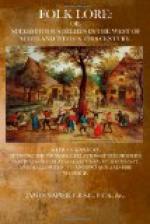Respecting this feast, Dr. Jamieson says, introducing a quotation from O’Brien, “Ignis Bei Dei Aseatica ea lineheil, or May-day, so called from large fires which the Druids were used to light on the summits of the highest hills, into which they drove four-footed beasts, using certain ceremonies to expiate for the sins of the people. The Pagan ceremony of lighting these fires in honour of the Asiatic god Belus gave its name to the entire month of May, which to this day is called Me-na-bealtine, in the Irish, Dor Keating.” He says again, speaking of these fires of Baal, that the cattle were driven through them and not sacrificed, the chief design being to avert contagious disorders from them for the year. And quoting from an ancient glossary, O’Brien says, “The Druids lighted two solemn fires every year, and drove all four-footed beasts through them, in order to preserve them from contagious distempers during the current year.” I am inclined to think that these notices describe a sort of modified or Christianized Beltane, that driving the cattle through the fire was a substitute for the older form of sacrificing cattle to the sun. Until very lately in different parts of Ireland, it was the common practice to kindle fires in milking yards on the first day of May, and then men, women, and children leaped through them, and the cattle were driven through in order to avert evil influences. They were also in the habit of quenching their fires on the last day of April, and rekindling them on the first day of May. In certain localities in Perthshire, so lately as 1810, (I have referred to this before), the inhabitants collected and kindled a fire by friction, and through the fire thus kindled they drove their cattle in order to protect them against disease, and at the same time they held a feast of rejoicing.
As already mentioned, the Romans held several festivals at the beginning of summer, and many of their observances on these occasions were introduced into this country, and became incorporated with the Beltane practices. For example, the Romans held a festival in honour of Pales, the goddess of flocks and sheepfolds. The feast was termed Palilia. Lempriere states that some of the ceremonies accompanying the feast consisted in “burning heaps of straw, and in leaping over them; no sacrifices were offered, but purifications were made with the smoke of horse’s blood, and with the ashes of a calf that had been taken from the belly of its mother after it had been sacrificed, and with the ashes of beans; the purification of the flocks was also made with the smoke of sulphur, also of the olive, the pine, the laurel, and rosemary. Offerings of mild cheese, boiled wine, and cakes of millet were afterwards made. Some call this festival Palilia, because the sacrifices were offered to the divinity for the fecundity of their flocks.” There was also a large cake prepared for Pales, and a prayer was addressed to the divinity by shepherds, as thus given by Dr. Jamieson:—




